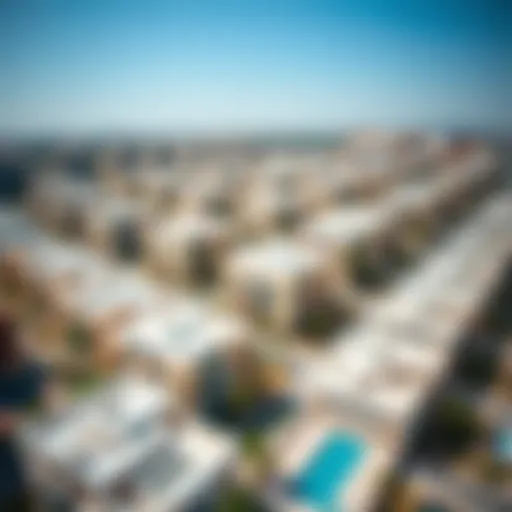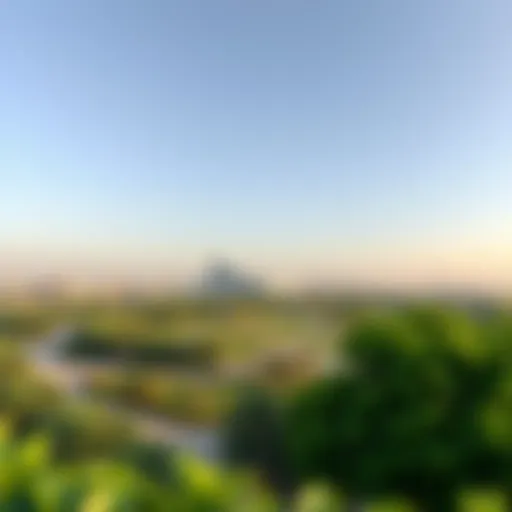Exploring the Nuances of Arabic Decoration in Modern Design
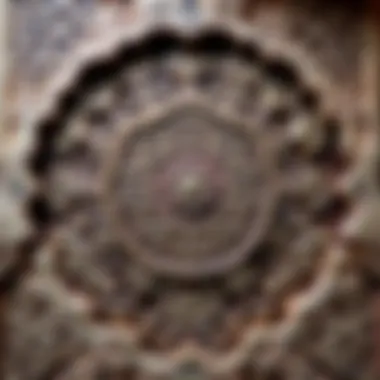

Intro
Arabic decoration is a tapestry rich in culture and history, weaving together the tales of its makers and the societies they inhabit. With origins that stretch back centuries, these intricate designs not only serve aesthetic purposes but also hold deep cultural significance. The motifs often tell stories of spirituality, nature, or daily life, resonating with the very soul of the communities that cherish them.
Exploring this topic is particularly relevant today, as Arabic decoration finds itself woven into the fabric of modern spaces. Nowhere is this blend more evident than in the bustling real estate market of Dubai. Here, contemporary architecture meets traditional craftsmanship, creating a unique backdrop for investors and homeowners alike. Understanding the nuances of Arabic decor can not only enhance the ambiance of a space but also elevate its market value. In this article, we will journey through the essential elements of Arabic decoration, unraveling traditional motifs, color palettes, and materials used, showcasing how they harmonize to create beautiful environments.
This exploration aims to enrich the reader's appreciation of Arabic design, offering insights that could well influence investment decisions in a rapidly evolving landscape.
"Arabic decoration is not just about what meets the eye; it’s about the story, history, and identity behind every detail."
As we peel back the layers, we will look into market trends, investment insights, and how these elements are evolving within the context of modern architecture.
The Essence of Arabic Decoration
In a world increasingly characterized by globalized aesthetics, Arabic decoration stands out as a vibrant testament to rich cultural narratives and deeply-rooted traditions. It's more than just embellishment—it's an embodiment of identity, a canvas where stories unfold through design. The splendor of Arabic decoration lies in how it fuses intricate aesthetics with profound meaning, making it invaluable to both homeowners seeking artistry in modern spaces and investors looking to highlight cultural sophistication in real estate.
Cultural Significance
Arabic decoration reflects a tapestry of values and beliefs, deeply intertwined with the communities that practice these arts. The aesthetic elements are not random; they symbolize concepts such as unity and eternity, often expressed through repetitive geometric patterns. These patterns create a visual harmony that resonates well beyond mere appearance—it invokes a sense of belonging. In many Arabic cultures, a beautifully decorated home is an extension of family values and hospitality, emphasizing spaces that invite conversation and connection.
Moreover, Arabic decoration acts as a bridge between tradition and modernity. For expatriates and homeowners in vibrant cities like Dubai, integrating Arabic design reminds them of historical roots even in a bustling contemporary environment. This layering of the old with the new offers a unique perspective that relates to the diverse population of the region. Ultimately, understanding the cultural significance of Arabic decoration enhances appreciation not only for aesthetics but also for the values it upholds.
Historical Roots
To grasp the essence of Arabic decoration, one cannot overlook its historical evolution, which spans centuries and draws from various influences. The origins can be traced back to ancient civilizations, where the fusion of diverse cultures—Persian, Byzantine, and North African—shaped unique styles. The introduction of Islam birthed distinct artistic expressions, refraining from figurative art in favor of intricate geometric designs and elegant calligraphy.
As trade routes expanded, so did the reach of Arabic decoration. Craftsmen exchanged ideas and techniques, leading to the birth of iconic styles like Moroccan tile work and Syrian mashrabiya (latticework). Each region developed its signature, embedding local materials and traditional craftsmanship into their creations. This historical tapestry underscores the dynamic nature of Arabic decoration, revealing how it absorbed and adapted influences while maintaining core cultural tenets. The journey through time illustrates that each pattern and motif tells a story, echoing the lives and values of those who came before us.
Key Elements of Arabic Design
In the realm of Arabic decoration, certain elements play a pivotal role in crafting designs that echo centuries of cultural heritage. These key components not only reflect aesthetic beauty but also embody deep-rooted traditions and philosophies. By grasping these elements, investors, agents, expatriates, and homeowners can better appreciate the art of Arabic design as it affects both the ambiance and value of properties.
Geometric Patterns
Geometric patterns are a hallmark of Arabic decoration, showcasing intricate designs that often appear almost hypnotic. These patterns can be found on everything from tiles to textiles. Often originating from Islamic art, these motifs represent infinity and the idea of divine perfection. The precision of these patterns demands an understanding of mathematical principles, something that resonates with many cultures.
These designs not only serve a decorative purpose but also evoke deeper philosophical meanings, representing the universe in a visually stunning manner.
Architects and designers make extensive use of geometric shapes to create rhythm and flow within a space. When expertly placed, geometric patterns can enhance visual landscapes and can be instrumental in creating zones or focal points in larger areas. They encourage the eye to travel, giving each room a dynamic sense of movement. In practical terms, incorporating geometric patterns in like ceramic tiles not only beautifies spaces but also makes them more intriguing.
Calligraphy and Script
Calligraphy is often viewed as the most revered form of art in Arabic culture. It transcends mere text, transforming words into elegant expressions that can adorn walls, scrolls, and furniture. The fluidity of Arabic script allows artists to bend and weave letters into intricate compositions, blending beauty with meaning.
One common practice is to inscribe verses from the Quran, which serves as a spiritual reminder and adds a layer of depth to the decor. Homeowners might choose specific phrases that resonate with them personally, fortifying the space's emotional significance. In a real estate context, properties decorated with thoughtful calligraphy can draw a unique type of buyer—one who seeks not just a house, but a sanctuary.
Additionally, calligraphy's appeal lies in its versatility—fitting seamlessly into both traditional and modern interiors. Whether used as an accent on cushions, in wall art, or even integrated into architectural features, calligraphy enriches spaces by adding a narrative quality.
Arabesque Motifs
Arabesque motifs take the artistry in Arabic design to another level. Characterized by its floral patterns entwined with foliage and geometric shapes, arabesque displays a sense of intertwining life and beauty. These motifs are not just decorative but symbolize the harmony found in nature.
Incorporating arabesque designs often involves a careful balancing act between complexity and subtlety. It provides a visual texture that can soften stark environments while infusing warmth. The delicacy of arabesque can lead to a luxurious feel, especially when displayed on lavish fabrics and wallpapers.
For the savvy investor, properties featuring arabesque designs often tend to stand out in a competitive market, not just by looks, but by expressing a story, a history, that connects potential buyers with the rich cultural backdrop of Arabic designs.
In summary, each of these key elements—geometric patterns, calligraphy, and arabesque motifs—contributes significantly to the essence of Arabic decoration. They combine to create spaces that are not just visually appealing but also profound in meaning and cultural significance.
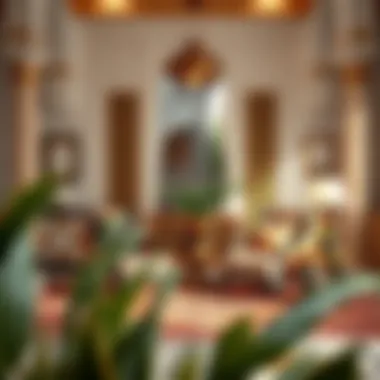

Color Schemes in Arabic Decor
Color plays a pivotal role in Arabic decoration, weaving visual stories that reflect the rich cultural tapestry of the region. It’s not simply about choosing colors; it’s about understanding their meanings, historical significance, and how they harmonize to create spaces that resonate with both history and emotion. When one considers Arabic decor, color schemes can convey status, spirituality, and identity, making their selection a vital aspect of any design.
One notable benefit of utilizing specific color palettes in Arabic decoration is their ability to evoke particular feelings and atmospheres. Warm hues like deep reds and ochres can promote an inviting environment, suitable for communal spaces, while cool tones such as blues and greens might induce a sense of tranquility, often ideal for private areas such as bedrooms or retreats. The right color can also create illusions of space or warmth, thereby making choices pivotal for the functionality of a room.
Whether for investors, homeowners, or decorators, understanding these color schemes is paramount. It’s about harmonizing the aesthetic appeal with the emotional and cultural narratives they carry. With that in mind, let’s delve into traditional color palettes.
Traditional Color Palettes
Traditional Arabic color palettes are steeped in symbolism and heritage, providing rich insight into the culture and the surrounding environments. Colors like deep saffron, vibrant turquoise, and earthy clay hues serve to harmonize with the natural landscape, reflecting the vast deserts and lush oases found in many Arabic regions.
- Saffron Yellow: This color symbolizes warmth and radiance, often associated with hospitality—a core value in many Arabic cultures. It tends to illuminate interiors, making them appear more inviting.
- Turquoise Blue: Borrowing from the hues of the Mediterranean and Arabian seas, this color represents tranquility, often used in tile work or ceramics, adding a calming effect to residential spaces.
- Rich Red and Maroon: Evoking prosperity and richness, reds are commonly found in textiles and decorative elements, enhancing the visual drama within the decor.
- Earthy Greens and Browns: These shades connect closely with nature and harmony, suitable for areas meant for relaxation or reflection, offering a sense of grounding.
Using these colors might also involve layering techniques and contrasts, where darker hues can support lighter accents, creating depth and interest in the decor. Intricate patterns often play a complementary role, ensuring that color usage doesn’t feel overwhelming.
Modern Interpretations
As trends evolve, modern interpretations of Arabic color schemes have emerged, marrying traditional nuances with contemporary aesthetics. This involves not only a change in palette but also an adaptation of how these colors are applied in interior design.
- Blending Tradition with Minimalism: Today, many designers choose neutral backdrops, allowing bold colors to serve as accent points. For instance, a room might feature a pale beige or soft gray base, punctuated by vibrant cushions or art that displays deep blues or vivid greens.
- Eclectic Color Combinations: Modern spaces often experiment with unconventional pairings, like emerald green against a backdrop of rose gold. These juxtaposed styles reflect a blend of cultures and eras, appealing to a diverse audience who appreciate the modern twist on age-old traditions.
- Sustainable Color Choices: With an increasing emphasis on sustainability, the choice of colors is extending into the realm of eco-friendly materials. Natural dyes are rising in popularity, giving textiles used in homes a unique touch and a story of their own.
A thoughtful consideration of color schemes in Arabic decoration helps in creating spaces that inspire awe, reflect culture, and invoke comfort, ultimately elevating the ambiance of any property.
Materials and Textures
In the realm of Arabic decoration, the materials and textures used play a pivotal role in defining the aesthetic and functional aspects of a space. These elements not only contribute to the visual allure but also encapsulate a rich narrative of culture and tradition. By examining different materials such as wood, stone, textiles, and fabrics, one can appreciate how they weave together the essence of Arabic design, embodying both historical significance and modern sensibilities.
Wood and Stone Use
The utilization of wood and stone in Arabic decor is as much about durability as it is about beauty. Wood, often sourced from local varieties like cedar or olive, is frequently ornately carved, showcasing intricate patterns that mirror the geometric motifs found throughout Arabic art. This craftsmanship not only highlights the skill of artisans but also adds a touch of warmth and authenticity to interiors. For instance, a beautifully crafted wooden door can serve as a stunning focal point in a room, reflecting the light in a captivating manner.
Stone, on the other hand, is often seen in the form of detailed masonry or flooring. Traditional materials like marble and granite not only offer strength but also elevate the aesthetic appeal of a space. The brilliance of polished marble, with its veined patterns, can transform a simple area into an opulent hall.
Together, wood and stone create a tactile experience that resonates with anyone who enters. They provide a connection to nature that is integral to many design philosophies found in Arabic culture.
- Benefits of Wood and Stone in Arabic Decoration:
- Durability and Longevity: Both materials can withstand the test of time, making them an investment for homeowners.
- Aesthetic Versatility: They can be finished or treated to fit a range of styles, from traditional to contemporary.
- Cultural Resonance: Using these materials pays homage to the heritage and artisanal traditions of the region.
Textiles and Fabrics
Textiles and fabrics in Arabic decoration bring color, pattern, and comfort into play. These elements often reflect the vibrancy of local culture, interwoven with stories passed down through generations. Luxurious fabrics like silk, brocade, and wool are common, often seen in cushions, drapes, and upholstery. The rich hues and elaborate patterns of these textiles can transform a mundane room into a vibrant sanctuary that invites relaxation and communal gathering.
Moreover, textiles serve a functional purpose. Heavy drapes can moderate light levels and temperatures, crucial in warmer climates, while vibrant cushions can enhance seating arrangements, promoting comfort and togetherness.
- Considerations When Selecting Textiles:
- Texture Variety: Mixing various textures can create depth and intrigue in a space, inviting touch and engagement.
- Color Matching: Aligning fabric colors with other design elements ensures a coherent visual flow.
- Cultural Patterns: Incorporating traditional designs can deliver authenticity and a homage to heritage.
"In Arabic homes, textiles are not just functional; they are a language of their own, telling stories and adding layers of meaning.”
The thoughtful interplay of materials and textures not only uplifts the aesthetics of Arabic decoration but also fortifies a deeper understanding of its cultural underpinnings. For investors and homeowners alike, grasping these nuances can unveil pathways to creating spaces that are not only beautiful but profoundly meaningful.
Furniture Styles and Arrangements
When discussing Arabic decoration, the style and arrangement of furniture plays a crucial role. Not merely functional, furniture in Arabic interiors often serves as an expression of culture, history, and artistry. This section aims to shed light on how different styles of furniture, along with thoughtful arrangements, can significantly influence the aesthetics and functionality of a space.
Traditional vs. Contemporary Furniture


Arabic furniture boasts an impressive range, from traditional pieces that reflect centuries of craftsmanship to contemporary forms that embrace minimalism and functionality.
Traditional Furniture: This type often displays intricate carvings, rich textiles, and bold colors. For instance, a majlis, a traditional sitting area, embodies not just seating but the very essence of social interaction and hospitality in Arab culture. Cushioned benches, often adorned with detailed embroidery, provide comfort and warmth.
Contemporary Furniture: It's a different ball game entirely. Modern designs focus on streamlined forms and subtle tones while still nodding to cultural roots. For example, you might find sleek wooden tables with glass accents that maintain the elegance of Arabic style but in a fresh way. The pieces may also incorporate materials like metal or acrylic, adding a touch of modernity.
Incorporating furniture style doesn't just enhance visual appeal; it also supports the lifestyle and activities that unfold within a space. Traditional furniture might foster a sense of community and formality, while contemporary pieces often create an atmosphere of ease and flexibility.
Functional Layouts
The arrangement of furniture is as significant as the styles chosen. An effective layout not only maximizes the use of space but also enhances the overall ambiance, making the setting warm and inviting.
When designing a room, consider these key aspects for functional layouts:
- Zoning: Divide spaces into areas for different activities. For example, create a cozy sitting nook separate from dining spaces. This not only saves space but also improves the flow of movement within a room.
- Flow of Movement: Ensure people can move freely without bumping into furniture. In traditional settings, you might find lower tables accompanied by floor cushions, promoting casual interaction. Meanwhile, modern layouts might feature larger sectional sofas that encourage fluidity and conversation.
- Focus Points: Place larger or striking pieces of furniture in a way that draws the eye. A grand chandelier or a beautifully crafted table can serve as an anchor in a room, creating focal points that guide the overall design.
"Arranging furniture isn't just about looks; it's about creating a home where people can thrive together."
In summary, selecting the right furniture styles alongside functional arrangements can significantly elevate the effect of Arabic decoration. Careful consideration of how these elements interact is essential for fostering spaces that feel both beautiful and lived in, resonating with the rich heritage and modern dynamics of Arabic design.
Arabic Decoration in Modern Spaces
Arabic decoration in contemporary settings holds a significant role, particularly in cosmopolitan hubs like Dubai. This blend of the old with the new enables homeowners and investors to harness a style that resonates deeply with history while being relevant in today’s architectural landscape. Understanding this concept is essential in appreciating how traditional motifs and modern living can coexist harmoniously.
Incorporating Traditional Elements
Incorporating traditional elements into modern spaces is a way to infuse a story and culture into the design. Items such as intricate tile work, ornate lanterns, and classic wooden furniture can breathe life into a room, creating a bridge between eras. For example, a beautifully crafted muqarnas ceiling can add depth and character to an otherwise stark interior.
Here are key aspects to consider:
- Tiles and Mosaic: Using local artisans to create bespoke mosaics can make a singular feature wall that captures traditional artistry.
- Carving Techniques: Wooden furniture or decorative pieces featuring Arabesque designs can often serve as conversation starters.
- Textiles and Patterns: Incorporating rich textiles, such as silk or woven fabrics, helps to add warmth and elegance, complementing minimalist furniture well.
In essence, blending these traditional elements with sleek, modern lines offers a sort of dialogue between different design philosophies, engaging the audience and emphasizing the continuity of culture through aesthetics.
Creating Balance with Minimalism
While embracing tradition is vital, balancing it with minimalism can be a tricky dance. Minimalism emphasizes simplicity and functionality, which might initially seem at odds with Arabic decoration, known for its detailed ornamentation. However, the two can work together effectively when approached mindfully.
To achieve this balance:
- Selective Features: Choose a few standout pieces like a grand carved wooden door or a uniquely designed fountain, allowing these elements to shine without overwhelming the space.
- Neutral Foundations: Keep the overall color palette neutral, allowing vibrant traditional colors to pop without clashing. For example, a muted beige or light gray backdrop can enhance terracotta tiles or intricate wall hangings.
- Defined Spaces: Create open and airy settings with well-placed furniture that maintains function without sacrificing aesthetics, like low seating arrangements around a central decorative piece.
"In a world where trends may come and go, the harmony of Arabic design within minimalistic environments showcases the timelessness of tradition."
Ultimately, the challenge lies in merging these contrasting styles in ways that do not feel forced. When executed thoughtfully, the subtle inclusion of Arabic decoration can elevate a space, providing both character and a sense of history amid the modern hustle and bustle.
The Role of Art in Arabic Decoration
Art has always held a prominent position in Arabic decoration, intertwining with cultural norms, historical narratives, and personal expression. It doesn't merely serve as a decorative touch; it's a statement of identity, belief, and craftsmanship. From intricate craftsmanship found in local pottery to the grand scale of architectural design, art is the thread that weaves together the various elements of Arabic decor.
Ceramic Arts and Crafts
Ceramic art stands as a testament to the region's legacy. It's a blend of functionality and beauty, showcased in everyday items like plates and jars. The artistry involved in creating ceramics reflects both technical skill and cultural significance. For instance, Iznik ceramics, famous for their vibrant colors and intricate floral designs, originate from Turkey but have found a second home throughout the Arab world. They demonstrate how patterns can tell stories—often depicting scenes from nature or geometric shapes that resonate on a deeper level.
Key Aspects of Ceramic Arts:
- Cultural Heritage: Each design often has roots linked to historical events, architectural influences, or even religious themes.
- Craftsmanship: The techniques used, such as hand-sculpting or glazing, require skill passed through generations.
- Functionality: Beyond aesthetics, ceramics serve practical purposes, making them an integral part of daily life and celebrations.
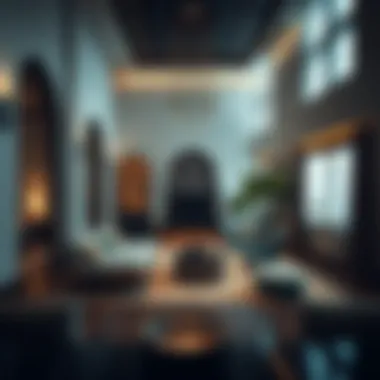

Mosaic Techniques and Their Applications
Mosaic art represents another cornerstone of Arabic decoration, where pieces of colored glass, stone, or tiles come together to form breathtaking patterns and images. The delicate nature of mosaics requires a high level of precision and creativity, making them a celebrated craft. These artworks are often found in places of worship, public spaces, and luxury residences, providing a touch of grandeur.
"Mosaics act as windows into the soul of a culture, revealing its history and aesthetics."
Applications of Mosaic Techniques:
- Architectural Elements: Mosaics can enhance the beauty of ceilings, floors, or walls, creating harmonious environments.
- Public Spaces: Many fountains or parks integrate mosaic designs, inviting the public to engage with art in their daily lives.
- Personal Dwellings: Homeowners often incorporate mosaics into their personal spaces, showcasing individuality while preserving tradition.
Influence of Arabic Decoration in Dubai's Real Estate Market
Arabic decoration plays a pivotal role in shaping the real estate scene in Dubai, a city that serves as a melting pot of global cultures. With its unique blend of tradition and modernity, the incorporation of Arabic aesthetic principles into design projects not only enhances property values but adds character to developments. This section will explore how traditional Arabic motifs and styling impact the architecture and overall market trends in this vibrant city.
Architectural Styles in Dubai
The architectural landscape of Dubai is a visual feast where contemporary skyscrapers rub shoulders with traditional palaces that echo the elegance of Arabic design. Various architectural styles have emerged that are steeped in cultural heritage yet adapted for modern living.
For example, builders are increasingly leaning towards designs that feature arched doorways, intricate tile work, and lush courtyards, allowing for airflow and natural light – principles rooted in traditional Islamic architecture. Noteworthy projects like the Burj Khalifa and the Al Fahidi Historical Neighborhood showcase this blend beautifully. The former, while a symbol of modernity, still incorporates elements that pay homage to Islamic principles.
Another important element to consider is the use of high-quality materials often associated with Arabic design, such as marble and ornate woodwork. Many developments now feature these materials prominently, creating a luxurious ambiance that appeals to potential buyers and investors alike.
Market Trends Favoring Traditional Design
In recent years, there has been a noticeable shift in the preferences of investors and homeowners in Dubai. More and more people are showing an inclination toward developments that resonate with traditional design elements rather than the ultra-modern, sometimes stark, minimalism that characterized earlier constructions.
This trend can be attributed to several factors:
- Cultural Connection: Buyers, especially expatriates and locals, feel a sense of nostalgia and connection when they encounter traditional motifs, making these properties more desirable.
- Sustainability: Developers are becoming increasingly aware of the importance of sustainable design that respects cultural heritage and uses local materials.
- Luxury Appeal: Properties that integrate Arabic decoration are often perceived as more luxurious, thus commanding higher prices on the market.
Investors are keen to capitalize on this trend, recognizing that homes imbued with cultural significance not only offer financial potential but also emotional value for its inhabitants.
"Dubai's real estate market is a living collage of cultures, but it is the robust Arabic design aesthetics that lend it depth and resonance."
To summarize, Arabic decoration has profound effects on Dubai's real estate market. From architectural styles to shifting market preferences, understanding these elements not only enriches one’s appreciation of the properties but also aids in making informed investment decisions.
Future of Arabic Decoration
The future of Arabic decoration is a melding pot of tradition and innovation. As global influences seep into every aspect of life, the ways in which Arabic decor evolves are becoming more pronounced. It's a fascinating time for those who appreciate the rich tapestry of Arabic design, and understanding its trajectory is vital for investors, homeowners, and designers alike. With a combination of historical appreciation and forward-thinking approaches, the future of Arabic decoration holds promise for redefining spaces across the world.
Adapting to Global Trends
In today’s interconnected world, no culture stands alone. Arabic decoration, steeped in its own historical context, is no exception. Adapting to global trends does not mean losing authenticity; instead, it opens doors to a dialogue between past and present. For instance, contemporary designers might blend traditional Arabic motifs with Scandinavian minimalism or Japanese simplicity. This approach leads to a new genre, where rich colors harmonize with neutral palettes, creating a soothing yet intriguing ambiance.
The incorporation of smart technology should also be considered. Automated lighting and smart fixtures can enhance the elaborate designs characteristic of Arabic interiors, allowing for dynamic lighting schemes that change the mood of a room.
Some key aspects to consider in this adaptation include:
- Fusion Designs: Find a balance between traditional elements and modern aesthetics, like mixing classic tilework with sleek furniture.
- Cultural Reverence: Approach global influences with respect, ensuring that cultural significances are upheld while engaging with new ideas.
- Audience Engagement: Understanding the expectations of an increasingly diverse clientele can shape the way decor is implemented and perceived.
As markets evolve, particularly in vibrant hubs like Dubai, the success of Arabic decoration in the future lies in its ability to stand out while being part of a global conversation.
Sustainability in Design
Sustainability is no longer just a buzzword; it’s become a cornerstone principle shaping the future of all design, including Arabic decoration. Engaging in eco-friendly practices is crucial not only for protecting the planet but also for preserving the cultural integrity of materials used in Arabic decor. Many traditional methods of decoration inherently lend themselves to sustainable practices, providing a perfect opportunity to marry heritage with modern ecological sensibilities.
Elements such as local sourcing of materials, eco-friendly dyes for textiles, and the use of sustainably harvested wood can make a significant impact. Moreover, retrofitting existing structures rather than new building can conserve resources and retain historical charm. Here are some considerations regarding sustainability in Arabic decoration:
- Use of Natural Materials: Emphasizing clay, stone, and sustainably sourced wood can enhance both aesthetic and environmental qualities.
- Energy Efficiency: Designing spaces that utilize natural light reduces the need for artificial lighting and lowers energy costs.
- Community Engagement: Supporting local artisans and craftsmen not only elevates the design quality but also ensures the continuance of traditional skills and techniques.
Ultimately, embracing sustainability in Arabic decoration allows for a meaningful and responsible connection to our environment, ensuring that future generations can enjoy the beauty and intricacies of this art form.
"The future of Arabic decoration will depend on the embrace of both heritage and innovation, fostering a culture that values both history and the environment."
Exploring these crucial elements will prepare investors and homeowners to not only appreciate but also shape the future of Arabic decoration.



